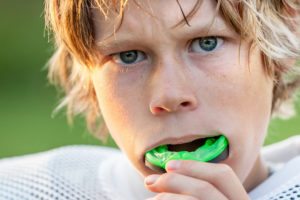 For many Tampa area children and teens, summer marks the start of sports season. While recreational activities can support healthy exercise habits and team-building skills, participating in contact sports puts children at risk for dental sports injuries. In fact, according to the American Academy of Pediatric Dentistry, sports accidents account for 10 to 39 percent of all dental injuries in children. Contact and collision sports such as baseball and basketball have the highest incidence of dental injuries, but even solo activities such as skateboarding, biking and roller skating have high dental injury rates. Luckily, there are two easy and affordable solutions parents can take to significantly reduce their child’s risk of oral injury.
For many Tampa area children and teens, summer marks the start of sports season. While recreational activities can support healthy exercise habits and team-building skills, participating in contact sports puts children at risk for dental sports injuries. In fact, according to the American Academy of Pediatric Dentistry, sports accidents account for 10 to 39 percent of all dental injuries in children. Contact and collision sports such as baseball and basketball have the highest incidence of dental injuries, but even solo activities such as skateboarding, biking and roller skating have high dental injury rates. Luckily, there are two easy and affordable solutions parents can take to significantly reduce their child’s risk of oral injury.
Buy your child a mouthguard
You wouldn’t let your child play football without a helmet or allow your soccer player to compete without knee pads, so why would you let him on the field without a mouthguard? Due to the high risk of sustaining a dental injury in contact sports, the Academy for Sports Dentistry strongly supports and encourages the use of a properly fitted mouthguard in all collision and contact sports.
A mouthguard’s job is to absorb the energy at the site of impact, thereby protecting the lips and mouth from bruising and cuts, as well as the teeth and jaw from fractures and dislocation. Using one is essential if your child plays any rough and tumble sport, whether that’s football, hockey or even gymnastics. Swimmers may be at risk for dental injury, too if they are not careful and collide into pool walls.
Custom-fitted mouthguards created by your child’s dentist are the most effective and preferred, but over-the-counter models are adequate for parents looking for a quick and inexpensive solution. However, these kinds of mouthguards don’t always fit well and can be uncomfortable, resulting in poor use and injury. In this respect, investing in a proper fitting mouthguard can save parents and their children a lot of time, money and pain in the long-run in from dental appointments due to sports-related injuries.
Encourage your child wear a helmet
Helmets, particularly ones designed with a faceguard, can significantly reduce the risk of injury to the head, face and mouth in contact sports, but choosing the right type of helmet is crucial for getting the protection that’s needed. For example, a cycling helmet won’t offer the proper protection for sports like hockey, and a football helmet might be too heavy for playing baseball. As always, don’t let your child cycle, skate or ski without a helmet.
What to do if a dental injury occurs
Even if your child adheres to all the correct safety measures, accidents still happen. If your child does sustain a dental sports injury while playing, don’t panic. Follow these steps instead:
- If your child loses a permanent tooth, try to find it, and then keep it moist by placing it in milk or use a tooth preservation product approved by the American Dental Association.
- Have your child rinse his or her mouth with warm, salty water.
- Apply a cold compress to the area to decrease swelling and clean the area gently.
- See a dentist as soon as possible. Waiting may result in permanent damage and tooth loss.
Playing outside and participating in team sports are a precious part of growing up, so don’t let the fear of dental injury keep your child from doing what she loves. In most cases, equipping her with the right protective gear should be enough to prevent a serious dental injury.

